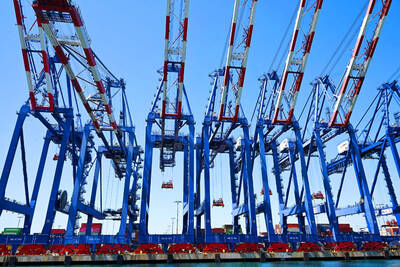Oil prices plummeted to a one-year low below US$83 a barrel yesterday in Asia as investor fears of a severe global economic downturn sparked a panicked sell-off of equities and crude.
Light, sweet crude for November delivery was down US$4.00 to US$82.59 a barrel in electronic trading on the New York Mercantile Exchange by mid-afternoon in Singapore, the lowest since last October. The contract overnight fell US$1.81 to settle at US$86.62.
“The whole market has lost confidence in everything,” said Mark Pervan, senior commodity strategist with ANZ Bank in Melbourne. “Everyone is worried about global growth, and oil is the front line commodity for that. There’s just a lot of panic and fear in the market.”
Investors were unimpressed by interest rate cuts by the US and other central banks this week to unclog credit markets and promote lending. A credit crisis that began last year in US subprime mortgages has spread across the globe, forcing governments to spend hundreds of billions of dollars to bail out banks, brokerages and insurance firms.
Japan’s benchmark Nikkei 225 index plunged 9.6 percent yesterday, while the Dow Jones industrial average fell more than 7 percent on Thursday to its lowest in five years.
“The problem is no one really knows how far and deep this will go,” Pervan said. “But we can see from the size of the rescue packages, this is a really serious deal. This isn’t a normal bear market.”
Investors even ignored signs that OPEC may cut production. OPEC said on Thursday that it would hold an extraordinary meeting on Nov. 18 to discuss the widening global financial crisis and oil prices.
On Thursday, the head of Libya’s national oil company, Shukri Ghanem, called on oil producing nations to cut output.
“OPEC is trying to jaw-bone the price up, but they’ll have to come into the market because no one is going to be believe just jaw-boning with the market sliding so quickly,” Pervan said. “The market is so demand-focused, it doesn’t even care what happens to supply.”
OPEC’s decision last month to cut production by 520,000 barrels a day failed to halt the losses, which have accelerated in recent days.
Oil prices have fallen about 44 percent since soaring to a record US$147.27 on July 11.
“We haven’t seen the bottom of this yet,” Pervan said. “We thought US$75 would be a floor but if the market mood doesn’t change, US$50 to US$60 a barrel is not out of the question.”
In other Nymex trading, heating oil futures fell US$0.0891 to US$2.33 a gallon, while gasoline prices dropped US$0.0863 to US$1.94 a gallon. Natural gas for November delivery fell US$0.224 to US$6.60 per 1,000 cubic feet.

IN THE AIR: While most companies said they were committed to North American operations, some added that production and costs would depend on the outcome of a US trade probe Leading local contract electronics makers Wistron Corp (緯創), Quanta Computer Inc (廣達), Inventec Corp (英業達) and Compal Electronics Inc (仁寶) are to maintain their North American expansion plans, despite Washington’s 20 percent tariff on Taiwanese goods. Wistron said it has long maintained a presence in the US, while distributing production across Taiwan, North America, Southeast Asia and Europe. The company is in talks with customers to align capacity with their site preferences, a company official told the Taipei Times by telephone on Friday. The company is still in talks with clients over who would bear the tariff costs, with the outcome pending further

WEAKER ACTIVITY: The sharpest deterioration was seen in the electronics and optical components sector, with the production index falling 13.2 points to 44.5 Taiwan’s manufacturing sector last month contracted for a second consecutive month, with the purchasing managers’ index (PMI) slipping to 48, reflecting ongoing caution over trade uncertainties, the Chung-Hua Institution for Economic Research (CIER, 中華經濟研究院) said yesterday. The decline reflects growing caution among companies amid uncertainty surrounding US tariffs, semiconductor duties and automotive import levies, and it is also likely linked to fading front-loading activity, CIER president Lien Hsien-ming (連賢明) said. “Some clients have started shifting orders to Southeast Asian countries where tariff regimes are already clear,” Lien told a news conference. Firms across the supply chain are also lowering stock levels to mitigate

NEGOTIATIONS: Semiconductors play an outsized role in Taiwan’s industrial and economic development and are a major driver of the Taiwan-US trade imbalance With US President Donald Trump threatening to impose tariffs on semiconductors, Taiwan is expected to face a significant challenge, as information and communications technology (ICT) products account for more than 70 percent of its exports to the US, Chung-Hua Institution for Economic Research (CIER, 中華經濟研究院) president Lien Hsien-ming (連賢明) said on Friday. Compared with other countries, semiconductors play a disproportionately large role in Taiwan’s industrial and economic development, Lien said. As the sixth-largest contributor to the US trade deficit, Taiwan recorded a US$73.9 billion trade surplus with the US last year — up from US$47.8 billion in 2023 — driven by strong

RESHAPING COMMERCE: Major industrialized economies accepted 15 percent duties on their products, while charges on items from Mexico, Canada and China are even bigger US President Donald Trump has unveiled a slew of new tariffs that boosted the average US rate on goods from across the world, forging ahead with his turbulent effort to reshape international commerce. The baseline rates for many trading partners remain unchanged at 10 percent from the duties Trump imposed in April, easing the worst fears of investors after the president had previously said they could double. Yet his move to raise tariffs on some Canadian goods to 35 percent threatens to inject fresh tensions into an already strained relationship, while nations such as Switzerland and New Zealand also saw increased